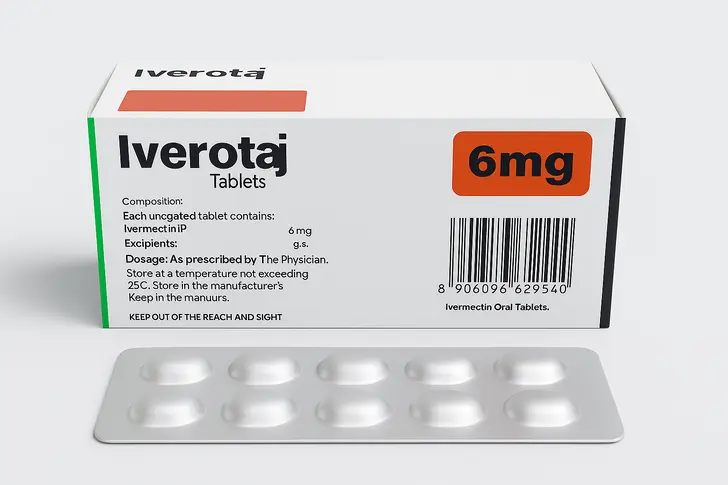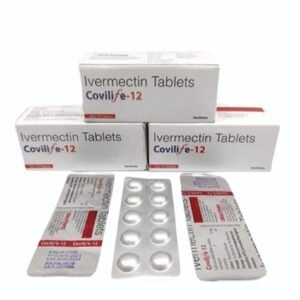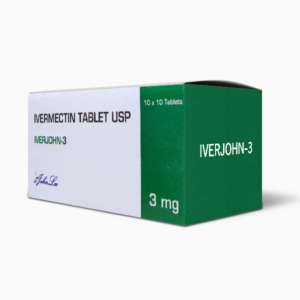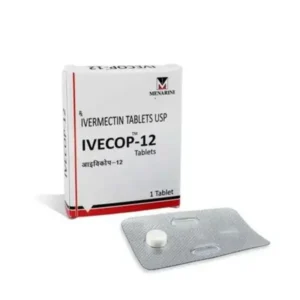Iverotaj 6 mg is a medication that is used to cure parasitic infections and contains ivermectin. It disables and kills the parasites, helping to effectively relieve conditions such as onchocerciasis, strongyloidiasis, scabies, and lice.
Ivermectin binds to glutamate-gated chloride channels in the nerve and muscle cells of the parasite that results inti paralysis and ultimately death of a parasite.
| About Iverotaj 6 mg |
|---|
| Drug Class: Anthelmintic (anti-worm) medication |
| Subclass: Avermectin |
| Product Details | |
|---|---|
| Composition | Active ingredient: Ivermectin Inactive ingredients: • Microcrystalline cellulose • Magnesium Stearate • Colloidal Silicon Dioxide • Croscarmellose Sodium • Pregelatinized Starch |
| Packaging Type | Tablet |
| Pack Size | 10×10 |
| Dosage | 6 mg |
| Therapeutic Class | Antiparasitic |
| Action Class | Paralyzes parasites |
| Chemical Class | Macrocyclic Lactone |
| Manufacturer | Taj Pharma Ltd |
| Shelf Life | 2–3 years from the date of manufacturing |
| Usages | Treats parasitic infections such as Strongyloidiasis, Onchocerciasis, Scabies, and other parasitic infections. |
| Country of Origin | India |
| Storage | Store away from direct sunlight and moisture |
How does Iverotaj 6 mg Work?
- Binding to glutamate-gated chloride channels: Ivermectin binds to particular receptors in the parasite nervous system, making the parasite’s nervous system permeable to chloride ions.
- Disrupting neural activity: The entry of chloride ions hyperpolarizes the neurons, causing an inhibitory effect on the nervous system of the parasite.
- Paralyzing and killing parasites: Disrupting the neural activity eventually paralyzes and kills the parasites.
Dosage
A standard dose of Iverotaj 6mg is usually one oral tablet taken on an empty stomach. Based on the level of infection, more doses can be taken after consulting a medical professional. It is important to take strictly what is prescribed to ensure optimal effectiveness while reducing resistance chances. Ivermectin dosage differs according to the condition treated and the patient’s weight and age. Some guidelines are as follows:
- Strongyloidiasis: A single oral dose of 200 mcg/kg body weight, administered on an empty stomach with water.
- Onchocerciasis: A single oral dose of 150 mcg/kg body weight, administered on an empty stomach with water.
Side Effects
- Nausea
- Vomiting
- Diarrhea
- abdominal pain
- Dizziness
- headache
- Skin rash and itching
- Muscle and joint pain
Uses
- Iverotaj 6 mg is used to treat Strongyloidiasis: Intestinal infection caused by Strongyloides stercoralis
- It is used to treat Onchocerciasis (River Blindness): An infection caused by the Onchocerca volvulus
- Scabies can be treated by Ivermectin medicines: Skin infection caused due to mite infestation.
- Lice Infestations: This medication is a useful alternative when topical treatment is failing or inconvenient.
Interactions
It can interact with other drugs, including:
- Blood thinners: Risk of bleeding is increased
- Antiepileptic drugs: Efficacy is decreased or toxicity is enhanced
- Other antiparasitic drugs: Risk of adverse effects is increased
- Alcohol: Risk of side effects is increased
It is recommended to use only after consulting a medical professional or doctor and to inform them prior regarding your medical history.
Pharmacokinetics
- Absorption: Ivermectin is slowly absorbed following oral administration, with peak plasma levels achieved within 4-5 hours.
- Distribution: Ivermectin is distributed extensively in the body and is found in high concentrations in the liver and in fat tissues.
- Metabolism: Ivermectin is metabolized in the liver by cytochrome P450 enzymes.
- Excretion: Ivermectin is mainly excreted in the feces with a minimal amount excreted in urine.
Clinical Trials
- Strongyloidiasis: Ivermectin has been researched thoroughly for the treatment of strongyloidiasis, with cure rates varying from 64-100% in clinical trials.
- Onchocerciasis: It has been established through research that ivermectin is effective in decreasing skin microfilariae loads in onchocerciasis patients, with the reduction being more than 90% sustained for as long as 12 months after a single administration.
Precautions
- Pregnancy and lactation: Ivermectin should be applied cautiously in pregnant and breastfeeding women since its safety has not been confirmed.
- Children and elderly: Ivermectin should be applied cautiously in these groups since they could be more vulnerable to side effects.
- Neurological disorders: Ivermectin could exacerbate neurological disorders like seizures or meningitis.
Conclusion
Iverotaj 6 mg (Ivermectin) is a potent antiparasitic drug used to treat parasitic infections. It is usually well tolerated but can result in side effects and drug interactions. Proper adherence to the dosage and precautions must be observed to provide effective and safe treatment.
FAQs
-
What is Iverotaj 6 mg used for?
Iverotaj 12 mg is a medication that is used to cure parasitic infections such as onchocerciasis, strongyloidiasis, scabies, and lice.
-
How does Iverotaj 6 mg work?
Iverotaj 12mg acts by disrupting the parasite’s nervous system, eventually leading to death.
-
What can be the possible side effects?
The possible side effects of this medications are Nausea, Vomiting, Diarrhea, abdominal pain, Dizziness, headache, Skin rash, itching, Muscle and joint pain
-
Does Iverotaj medications shows any interaction?
Yes, Iverotaj medicine can interact with Blood thinners, Antiepileptic drugs, and Other antiparasitic drugs. So, it is recommended to use after consulting a doctor or medical professional.
-
Is Iverotaj 6 mg safe for everyone?
Yes, Iverotaj 6 mg is generally safe, but it is recommended to use after consulting medical professional.
References
https://pmc.ncbi.nlm.nih.gov/articles/PMC11008553/
https://pmc.ncbi.nlm.nih.gov/articles/PMC3043740/
| Iverotaj 6 | 30 Tablets $55, 50 Tablets $80, 100 Tablets $140, 300 Tablets $290 |
|---|
1 review for Iverotaj 6
You must be logged in to post a review.








Kaya Whitefeather –
Worth every penny.